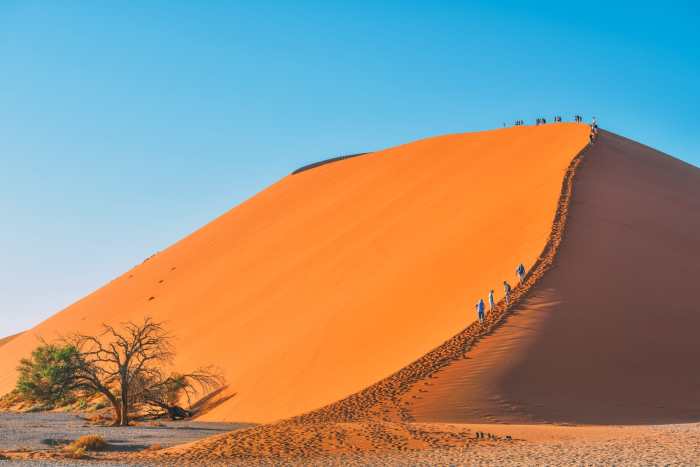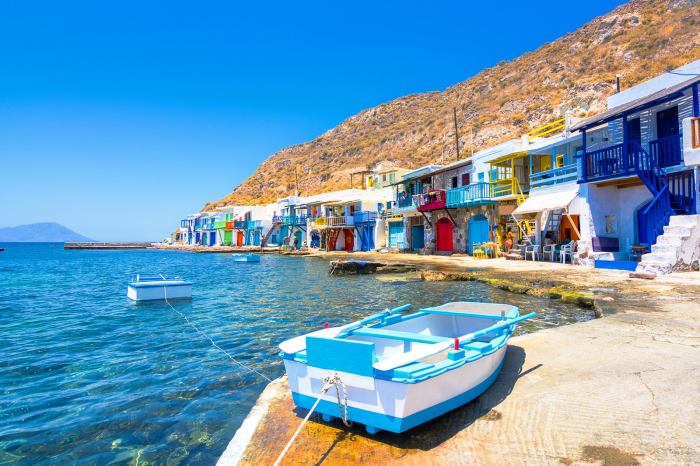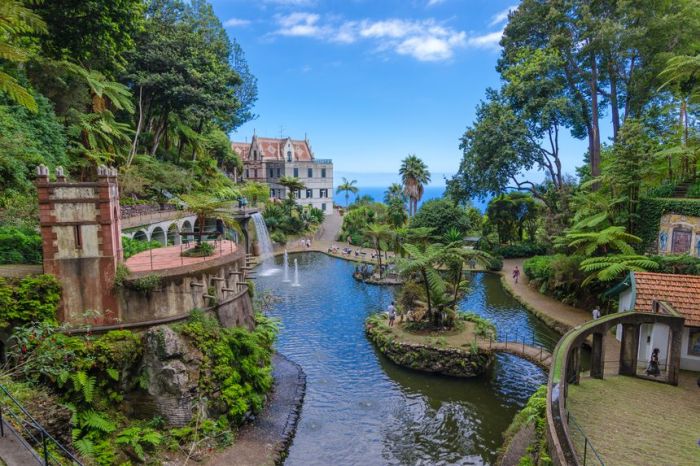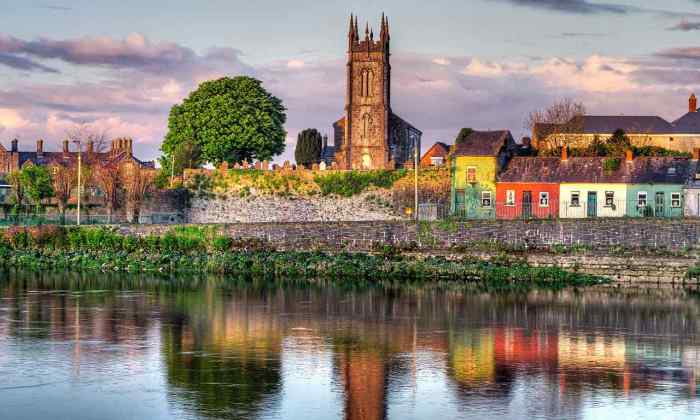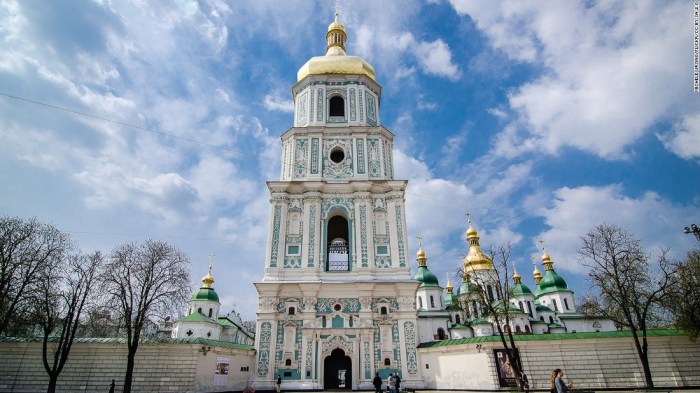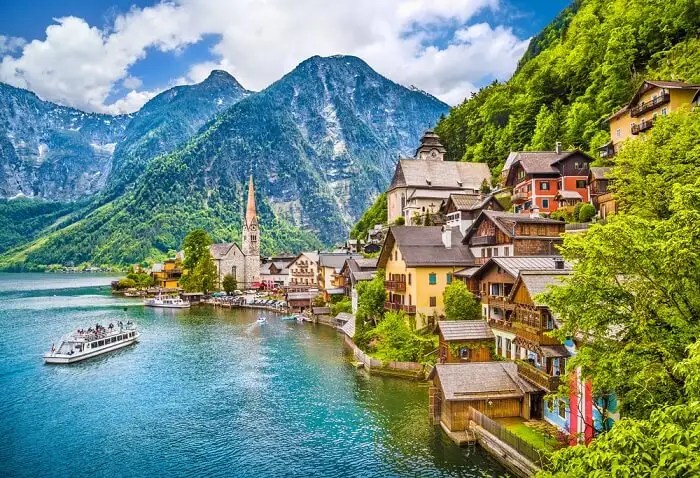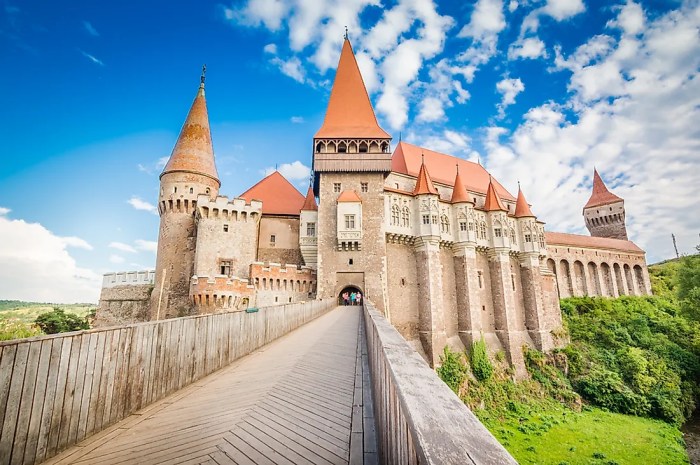Top 10 Places To Visit In Namibia
Top 10 Places To Visit in Namibia takes center stage, beckoning you to explore a country brimming with diverse landscapes and captivating experiences. From the vast expanse of the Etosha National Park, teeming with wildlife, to the otherworldly beauty of Sossusvlei’s red sand dunes, Namibia offers a tapestry of adventure and natural wonder.
Whether you’re a seasoned traveler seeking thrills or a curious explorer yearning for unique encounters, this list of top destinations promises an unforgettable journey. Prepare to be amazed by the rugged Skeleton Coast, the dramatic Fish River Canyon, and the ancient rock engravings of Twyfelfontein.
Discover the bustling charm of Swakopmund, the tranquility of Epupa Falls, and the historical allure of Lüderitz.
Etosha National Park
Etosha National Park, a true gem of Namibia, is a wildlife enthusiast’s paradise. Known for its diverse ecosystem and abundant wildlife, Etosha is a must-visit destination for any traveler seeking a thrilling safari experience.
The Diverse Wildlife Population
Etosha is renowned for its remarkable wildlife population, including the famed “Big Five”the lion, leopard, elephant, rhino, and buffalo. The park is home to a vast array of other animals, including zebras, giraffes, wildebeest, and countless bird species. The park’s diverse habitats, ranging from open grasslands to dense woodlands, provide ideal conditions for a variety of wildlife to thrive.
The Etosha Pan
The Etosha Pan, a vast, white, salt pan, is the defining feature of the park. This unique ecosystem plays a crucial role in the park’s ecology. During the rainy season, the pan fills with water, attracting a multitude of animals seeking sustenance and a place to cool down.
As the dry season sets in, the pan gradually dries up, leaving behind a shimmering expanse of white salt. The pan’s ecosystem is unique and fragile, and its presence makes Etosha National Park an exceptional destination.
The Best Time To Visit Etosha National Park
The best time to visit Etosha National Park for wildlife viewing is during the dry season, which runs from May to October. During this time, the animals congregate around the waterholes, making them easier to spot. The weather is also pleasant during the dry season, with warm days and cool nights.
The rainy season, from November to April, is characterized by lush vegetation and abundant water, making it an excellent time to see newborn animals. However, wildlife sightings can be more challenging during this time as the animals are more dispersed.
Sossusvlei and Deadvlei
Sossusvlei and Deadvlei, located in Namibia’s Namib-Naukluft National Park, are renowned for their breathtaking landscapes of towering red sand dunes. These natural wonders are a must-see for any visitor to Namibia.
The Formation of the Red Sand Dunes
The iconic red sand dunes of Sossusvlei are a testament to the powerful forces of nature. They are formed by the relentless wind that has been shaping the Namib Desert for millions of years. The wind carries fine-grained sand from the nearby Atlantic Ocean, depositing it in layers over time.
These layers of sand, rich in iron oxide, are what give the dunes their distinctive red color. The iron oxide reacts with oxygen, creating a rust-like hue that intensifies as the dunes age.
Sossusvlei and Deadvlei: A Comparison
Sossusvlei and Deadvlei are both located within the Namib-Naukluft National Park, but they offer distinct experiences.
- Sossusvleiis a clay pan, or a shallow depression, that fills with water after rare rainfall. The water attracts various bird species, creating a vibrant ecosystem. The surrounding dunes rise to impressive heights, offering stunning views from the pan.
- Deadvlei, meaning “dead valley,” is a dried-up clay pan that is surrounded by towering red dunes. The pan is devoid of water and vegetation, creating a stark and otherworldly landscape. The contrasting colors of the white clay pan against the red dunes create a striking visual effect.
The Contrasting Colors and Textures of Sossusvlei and Deadvlei
The visual contrast between Sossusvlei and Deadvlei is striking. Imagine a scene where towering red sand dunes, sculpted by the wind into mesmerizing shapes, frame a canvas of stark white clay. The dunes themselves are a tapestry of textures, with smooth, wind-swept surfaces and rough, rippled ridges.
Deadvlei, the dried-up clay pan, offers a stark contrast to the dunes, its surface smooth and cracked, a testament to the relentless sun and lack of water.The contrast in colors and textures is further emphasized by the play of light and shadow.
As the sun rises and sets, it casts long shadows across the dunes and the pan, creating a constantly changing spectacle. The deep red hues of the dunes are intensified by the sunlight, while the white clay of Deadvlei reflects the light, creating a shimmering effect.
Swakopmund and the Skeleton Coast: Top 10 Places To Visit In Namibia
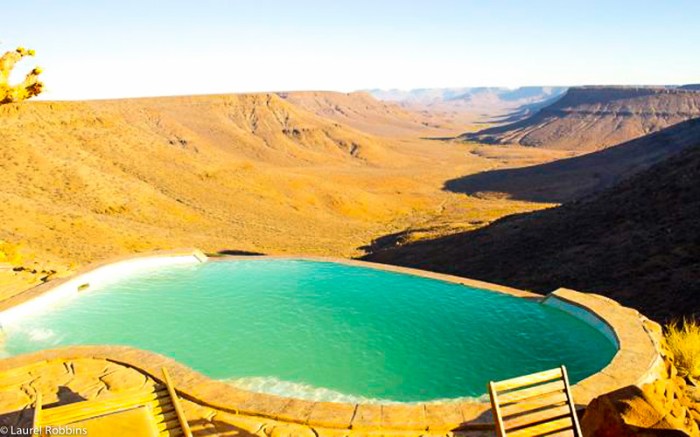
Swakopmund, a coastal town in Namibia, offers a unique blend of German colonial charm and adventure. It’s a gateway to the infamous Skeleton Coast, a stretch of desolate coastline known for its shipwrecks and dramatic landscapes. The Skeleton Coast is a harsh and unforgiving environment, where treacherous currents, dense fog, and shifting sands have claimed countless ships over the centuries.
But its beauty is undeniable, with towering dunes, jagged cliffs, and a diverse array of wildlife. Swakopmund, with its vibrant culture and thrilling activities, serves as the perfect base for exploring this remarkable region.
History and Significance of the Skeleton Coast
The Skeleton Coast has a rich and tragic history, marked by shipwrecks and the stories of those who perished in its unforgiving embrace. The name itself, derived from the Portuguese “Costa dos Esqueletos,” reflects the grim reality of the coastline, littered with the skeletal remains of ships and the bones of animals.
The coast is a treacherous stretch of land, where cold Benguela currents meet the warm waters of the Atlantic, creating dense fog and unpredictable waves. These conditions, combined with the lack of natural harbors and the presence of hidden reefs, have made the Skeleton Coast a graveyard for ships for centuries.
The Skeleton Coast has played a significant role in shaping Namibia’s history, serving as a source of conflict and resource extraction. It was once a major trading route for the Portuguese, who sought ivory, gold, and slaves. The coast also attracted European explorers and adventurers, who sought to map the region and claim its resources.
In the 20th century, the Skeleton Coast became a hub for diamond mining, attracting prospectors and entrepreneurs from around the world.
Adventurous Activities in Swakopmund
Swakopmund is a haven for adventure seekers, offering a range of thrilling activities for all levels of experience. The town’s proximity to the Skeleton Coast makes it an ideal base for exploring the rugged beauty of the Namib Desert.
Here are a few of the most popular activities:
- Sandboarding:One of the most popular activities in Swakopmund is sandboarding. The towering dunes of the Namib Desert provide the perfect playground for this exhilarating sport. Sandboarding is a great way to experience the unique landscape of the Skeleton Coast and enjoy a thrilling ride down the dunes.
Experienced sandboarders can tackle the steepest slopes, while beginners can learn the basics on gentler slopes. There are several sandboarding companies in Swakopmund, offering rentals and guided tours.
- Quad Biking:Another popular way to explore the Namib Desert is by quad bike. Quad biking is a great way to get off the beaten track and experience the rugged beauty of the Skeleton Coast. You can choose from a variety of tours, ranging from short scenic rides to multi-day expeditions.
Quad biking is a great way to see the diverse landscape of the Skeleton Coast, including the towering dunes, rugged cliffs, and the vast expanse of the desert.
- Skydiving:For the ultimate adrenaline rush, try skydiving over the Skeleton Coast. You can choose from a variety of jumps, ranging from tandem jumps to solo jumps. Skydiving offers stunning views of the Skeleton Coast and the Namib Desert.
It’s an unforgettable experience that will leave you breathless.
- Sea Kayaking:Explore the coastline from a different perspective with a sea kayaking tour. Sea kayaking is a great way to see the Skeleton Coast up close and personal. You can paddle through the crystal-clear waters of the Atlantic Ocean, spot dolphins and seals, and explore the rocky shores of the Skeleton Coast.
Unique Accommodations in Swakopmund
Swakopmund offers a variety of accommodations to suit every taste and budget. Here are a few unique accommodations that are located close to attractions:
- The Delightful Swakopmund Hotel:Located in the heart of Swakopmund, this hotel offers a blend of German colonial charm and modern amenities. The hotel is within walking distance of the town’s main attractions, including the Swakopmund Museum, the Jetty, and the waterfront.
The hotel features a variety of rooms and suites, all decorated in a classic style. Guests can enjoy a variety of amenities, including a swimming pool, a restaurant, and a bar.
- The Elegant Hansa Hotel:This hotel is located in a historic building in the heart of Swakopmund. The hotel offers a blend of modern amenities and classic German architecture. The hotel is within walking distance of the town’s main attractions, including the Swakopmund Museum, the Jetty, and the waterfront.
The hotel features a variety of rooms and suites, all decorated in a classic style. Guests can enjoy a variety of amenities, including a restaurant, a bar, and a swimming pool.
- The Adventure-Filled Swakopmund Guesthouse:This guesthouse is located on the outskirts of Swakopmund, offering a quiet and peaceful retreat from the hustle and bustle of the town. The guesthouse is a great base for exploring the Skeleton Coast and the Namib Desert. The guesthouse offers a variety of rooms and suites, all decorated in a rustic style.
Guests can enjoy a variety of amenities, including a swimming pool, a garden, and a barbecue area.
Fish River Canyon
The Fish River Canyon, located in southern Namibia, is one of the largest canyons in the world and a must-visit for any nature enthusiast. Its dramatic landscape, sculpted by millions of years of geological forces, offers breathtaking views and unparalleled hiking opportunities.
Formation and Geological Significance
The Fish River Canyon’s formation is a testament to the power of erosion and tectonic activity. The canyon was carved by the Fish River, which has been flowing through the area for millions of years. As the river cut through the earth, it exposed layers of ancient rock, revealing a geological history spanning billions of years.
The canyon’s dramatic cliffs and rugged terrain showcase the various rock formations, including sandstone, granite, and shale, providing a glimpse into Namibia’s geological past.
Hiking Trails within the Fish River Canyon
The Fish River Canyon offers a range of hiking trails catering to different levels of experience. The most popular trail is the Fish River Canyon Trail, a 5-day, 85-kilometer (53-mile) trek through the canyon’s heart. This challenging trail requires a permit and can only be undertaken with a licensed guide.
For a shorter and less demanding hike, the Hobas Hiking Trailoffers a variety of options ranging from a leisurely stroll to a more strenuous climb. For those seeking a truly unique experience, the Ai-Ais Hot Springs Trailcombines the beauty of the canyon with the therapeutic benefits of the hot springs.
Flora and Fauna within the Fish River Canyon
The Fish River Canyon is home to a diverse range of flora and fauna adapted to the harsh desert conditions.
| Category | Species | Mammals | Oryx, springbok, zebra, kudu, baboon, leopard | Birds | Ostrich, kori bustard, black-chested snake eagle, rock kestrel, Namaqua sandgrouse | Reptiles | Rock agama, leopard tortoise, Namib sand viper | Plants | Welwitschia mirabilis, quiver tree, desert rose, succulent euphorbias |
|---|
Twyfelfontein
Twyfelfontein is a UNESCO World Heritage Site in Namibia, renowned for its extensive collection of ancient rock engravings. These engravings, created by the San people, provide a fascinating glimpse into their lives and culture, dating back thousands of years.
The Historical and Cultural Significance of the Twyfelfontein Rock Engravings
The rock engravings at Twyfelfontein are a testament to the rich history and culture of the San people, who inhabited this region for millennia. These engravings, often referred to as “petroglyphs,” depict a wide range of subjects, including animals, humans, and abstract designs.
They offer invaluable insights into the San people’s beliefs, rituals, and daily lives. For example, the engravings of animals, such as giraffes, elephants, and rhinoceroses, reflect the San people’s deep connection to the natural world. These engravings may have served as hunting aids, storytelling devices, or expressions of spiritual beliefs.
The engravings also depict scenes of human activities, such as hunting, dancing, and storytelling. These scenes provide glimpses into the San people’s social structures, their relationships with each other, and their cultural practices.
The Process of Creating the Twyfelfontein Rock Engravings and Their Artistic Style
The San people created these engravings by carefully chipping away at the surface of the rock using sharp tools made from stone or bone. This process, known as “petroglyphing,” required skill and precision. The artistic style of the Twyfelfontein engravings is characterized by its simplicity and realism.
The San artists used a limited palette of lines, dots, and geometric shapes to create their images. This minimalist approach allowed them to effectively capture the essence of their subjects, conveying a sense of movement, emotion, and detail.
Preservation Efforts Implemented at Twyfelfontein
Recognizing the immense cultural and historical value of the Twyfelfontein rock engravings, significant efforts have been made to protect and preserve these artifacts. These efforts include:
- Establishing a protected area around the site to prevent vandalism and damage.
- Implementing strict visitor guidelines to minimize disturbance to the engravings.
- Conducting regular monitoring and maintenance to ensure the long-term preservation of the site.
- Raising awareness about the importance of the engravings through educational programs and outreach initiatives.
Cape Cross Seal Reserve
Namibia’s coastline is a haven for marine life, and one of its most remarkable sights is the Cape Cross Seal Reserve. This reserve is home to a massive colony of Cape fur seals, making it one of the largest breeding colonies in the world.The reserve is located about 100 kilometers north of Swakopmund, a popular coastal town.
The seals gather on the sandy beaches and rocky shores of the reserve, creating a truly awe-inspiring sight.
Breeding Season
The breeding season for Cape fur seals at Cape Cross is from June to December. During this time, the beaches become teeming with life as thousands of seals arrive to mate and give birth. The males, which are much larger than the females, engage in fierce competition for dominance and mating rights.
The females give birth to a single pup on the beach, and the pups stay with their mothers for several months while they nurse and learn to swim.
Conservation Importance
The Cape Cross Seal Reserve is crucial for the conservation of the Cape fur seal population. The seals are a valuable part of the marine ecosystem, and their numbers have been declining in recent years due to factors such as overfishing, habitat loss, and pollution.
The reserve provides a protected area where the seals can breed and raise their pups without being disturbed.
Importance of the Reserve
The reserve plays a vital role in the conservation of the Cape fur seal population. It provides a safe haven for the seals to breed and raise their pups. The reserve is also an important research site for scientists studying the ecology and behavior of these fascinating animals.
Namib-Naukluft National Park
The Namib-Naukluft National Park, encompassing the Namib Desert and the Naukluft Mountains, offers a breathtaking panorama of diverse landscapes. This vast expanse of sand dunes, canyons, mountains, and rocky outcrops is home to a remarkable array of desert-adapted flora and fauna.
Diverse Landscapes
The Namib-Naukluft National Park is a captivating tapestry of contrasting landscapes. The iconic red sand dunes of the Namib Desert, some reaching towering heights, dominate the park’s western regions. These dunes are sculpted by wind and time, creating a surreal and ever-changing landscape.
In stark contrast, the rugged Naukluft Mountains rise in the east, their jagged peaks and deep canyons offering a different kind of beauty. The park also boasts diverse geological formations, including the dramatic Tsauchab River Canyon, which cuts through the landscape, and the vast plains of the Namib Desert.
Desert-Adapted Flora and Fauna
The Namib-Naukluft National Park is a testament to the resilience of life in harsh environments. Its flora and fauna have adapted remarkably to the extreme conditions of the desert. The park’s vegetation includes hardy succulents, drought-resistant shrubs, and the iconic Welwitschia mirabilis, a unique plant that can live for thousands of years.
The park’s fauna includes a diverse array of desert-adapted animals, such as the elusive black-faced impala, the adaptable springbok, the agile gemsbok, and the rare desert elephant.
Camping Spots
The Namib-Naukluft National Park offers several camping spots, each with its unique charm and accessibility.
- Sesriem Campsite: Located near the entrance of the park, this campsite provides easy access to Sossusvlei and Deadvlei. It offers basic amenities, including flush toilets, showers, and a communal kitchen.
- Wolwedans Campsite: Situated in the heart of the Namib Desert, this campsite offers a truly remote and secluded experience. It provides basic amenities, including pit toilets and water points. Access to this campsite requires a 4×4 vehicle.
- Naukluft Mountain Zebra National Park Campsite: Located in the eastern part of the park, this campsite provides a gateway to the Naukluft Mountains. It offers basic amenities, including flush toilets, showers, and a communal kitchen.
Waterberg Plateau National Park
Escape the heat and immerse yourself in the captivating beauty of the Waterberg Plateau National Park. This unique park boasts a dramatic landscape of sandstone cliffs, lush vegetation, and diverse wildlife.
The Waterberg Plateau’s Geological Formation
The Waterberg Plateau is a massive, isolated sandstone plateau rising 600 meters above the surrounding plains. It was formed over millions of years by the erosion of ancient sedimentary rocks. The plateau is a testament to the region’s geological history and offers a glimpse into the earth’s past.
Diverse Wildlife
The Waterberg Plateau National Park is a haven for a wide array of wildlife. Its diverse habitat supports a variety of animals, including:
- White rhinoceros: The park is home to a significant population of white rhinoceros, one of the “Big Five” animals. This endangered species is protected within the park’s boundaries.
- Elephant: Large herds of elephants roam the park, often seen grazing in the grasslands and woodlands.
- Lion: These majestic predators are occasionally spotted in the park, often at night.
- Leopard: These elusive cats are skilled hunters and can be seen at night or in the early morning.
- Cheetah: These swift predators are also found in the park, particularly in the open grasslands.
- Giraffe: Giraffes are a common sight in the park, their long necks reaching for leaves high in the trees.
- Zebra: Herds of zebra graze in the open grasslands, adding to the park’s diverse ecosystem.
- Blue wildebeest: These large antelopes are often seen in herds, migrating across the park.
- Springbok: This agile antelope is well-adapted to the arid environment and is a common sight in the park.
- Kudu: These spiral-horned antelopes are found in the park’s woodlands and thickets.
Hiking Trails and Activities, Top 10 Places To Visit in Namibia
The Waterberg Plateau National Park offers a variety of hiking trails that cater to different fitness levels.
- The Waterberg Hiking Trail: This challenging trail offers stunning views of the plateau and surrounding landscape. It takes approximately 3-4 days to complete and requires a permit.
- The Waterberg Nature Trail: This shorter and easier trail is ideal for families and those looking for a more leisurely hike. It offers glimpses of the park’s diverse wildlife and flora.
- Game Drives: Guided game drives offer the best opportunity to spot the park’s diverse wildlife, especially in the early morning and late afternoon.
- Birdwatching: The park is a haven for birdwatchers, with over 250 species recorded. Look out for the iconic African fish eagle and the colorful lilac-breasted roller.
Epupa Falls
Epupa Falls, situated in the Kunene River on the border between Namibia and Angola, is a captivating natural wonder that enchants visitors with its raw beauty and cultural significance. The falls cascade over a series of rocky steps, creating a mesmerizing spectacle of water, mist, and lush vegetation.
The Cultural Significance of Epupa Falls
Epupa Falls holds deep cultural significance for the Himba people, who have lived in the region for centuries. The falls are a vital source of water for the Himba, and they have long been a place of spiritual significance. The Himba believe that the falls are home to powerful spirits, and they often perform ceremonies and rituals at the falls to honor these spirits.
“Epupa Falls is a place where the past, present, and future come together. It is a place of great beauty and spiritual power, and it is a reminder of the importance of respecting the natural world.”
A Himba elder
Lüderitz
Lüderitz, a coastal town in southwestern Namibia, offers a captivating blend of history, unique architecture, and adventure opportunities. The town boasts a rich colonial past, evident in its distinctive buildings and historical sites, while its surrounding landscapes provide a playground for thrill-seekers.
The Historical Significance of Lüderitz
Lüderitz’s history is intertwined with the colonial era, particularly the German influence in the late 19th and early 20th centuries. The town was founded in 1883 by Adolf Lüderitz, a German merchant who established a trading post. Lüderitz’s strategic location along the coast, coupled with the discovery of diamonds in 1908, attracted German settlers and sparked a period of intense colonial activity.
This period left an indelible mark on the town’s architecture and culture.
Unique Architecture and Attractions
Lüderitz is known for its distinctive architectural style, a fusion of German colonial influences and local adaptations. The town’s buildings feature prominent examples of German architecture, including the
- Felsenkirche* (Rock Church), a striking church built into a rock face, and the
- Kolmanskop Ghost Town*. The
- Kolmanskop Ghost Town* is a captivating sight, a deserted diamond-mining town swallowed by the desert sands. This eerie town offers a glimpse into the town’s colonial past, with its decaying buildings, sand-covered furniture, and abandoned machinery. Other notable attractions include the Lüderitz Museum, which houses a collection of artifacts showcasing the town’s history and culture, and the
- Diaz Point*, the southernmost point of Namibia, where the Portuguese explorer Bartolomeu Dias landed in 1487.
Adventure Activities in the Lüderitz Area
Lüderitz offers a range of adventure activities for outdoor enthusiasts. The surrounding coastline is ideal for kayaking and diving, allowing visitors to explore the rugged cliffs, hidden coves, and diverse marine life. Kayaking tours provide an opportunity to navigate the calm waters of the Lüderitz Bay, while diving expeditions offer a chance to witness the vibrant underwater world, including the famous Lüderitz Canyon.
The town also serves as a gateway to the
Skeleton Coast*, a desolate and treacherous stretch of coastline known for its shipwrecks and dramatic landscapes.
Last Word
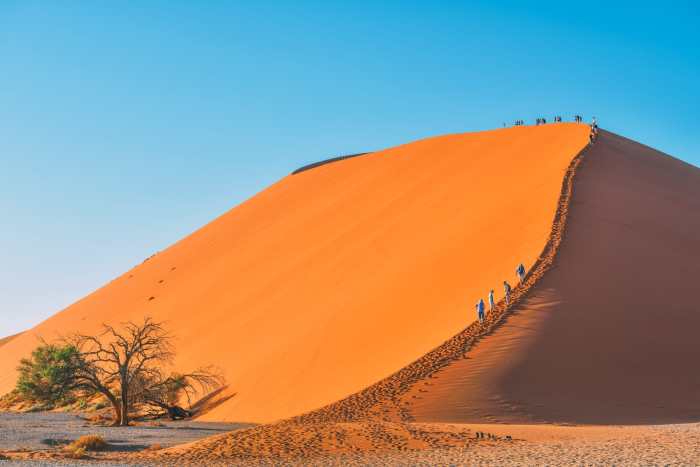
As you traverse Namibia’s diverse landscapes, from the vast plains to the towering mountains, you’ll be captivated by the raw beauty and rich cultural heritage that define this extraordinary country. Each destination offers a unique perspective on Namibia’s soul, leaving you with lasting memories and a newfound appreciation for the wonders of the natural world.
FAQ Explained
What is the best time of year to visit Namibia?
The best time to visit Namibia is during the dry season, from May to October, when the weather is clear and sunny, and wildlife is easier to spot.
What currency is used in Namibia?
The official currency of Namibia is the Namibian dollar (NAD), but South African rand (ZAR) is widely accepted.
Do I need a visa to visit Namibia?
Visa requirements vary depending on your nationality. It’s best to check with the Namibian embassy or consulate in your country for the most up-to-date information.
